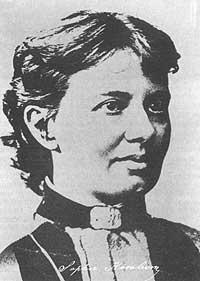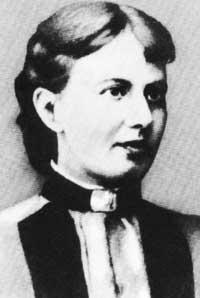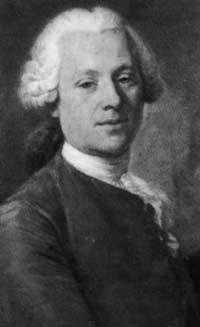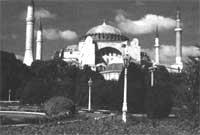Sofia Kovalevskaia (1850-1891)
1991/11/01 Duoandikoetxea Zuazo, Javier - EHUko matematika irakaslea Iturria: Elhuyar aldizkaria
Sofia Korvin-Krukovsky was born in Moscow on 15 October 1850. She was the second daughter of an army general. On the part of his father they belonged to the lineage of the Kings of Hungary, while in his mother's family they tended to science, since the grandfather was a mathematician and the great-grandfather was an astronomer.
As her parents are part of the Russian nobility, Sofia spent her first years on that social level, as her novel based on memories of that time shows. As usual, private education teachers took him home. In the family, his uncle Piotr talked to him about the subjects of mathematics and, although he did not understand it, Sofia listened to his conversations at ease.
There is also a curious anecdote that he himself related: on the wall of a room in the house, in the absence of paper, the leaves of a book were placed; those of the book Differential and Integral Calculus of Ostrogadski. The symbols seen on that wall seemed wonderful to him and those he met when he had the opportunity to learn the Calculus.

Being a woman was a great obstacle to the higher career. In that Russia they were forbidden access to the University and his father did not want to allow his daughter to leave the house. But Sofia and her sister were not willing to give in without a fight and, in the absence of another path, they had to follow the usual: one of them had to marry if they wanted to acquire the freedom to leave the house.
At 18 he married Sofia Vladimir Kovalevsky, a student of Paleontology. The following year the couple moved to Heidelberg and while her husband was studying Geology, Sofia studied Physics with Königsberger and Du Bois-Reymond with Mathematics and Kirchhoff and Helmholtz. Those teachers immediately realized the capacity of the girl and Königsberger, a former student of Weierstrass, advised her to come to her.
The idea of being next to Weierstrass was no less. This 55-year-old Berlin was the most famous mathematician of the time and the classes he taught at the University of Berlin were of great prestige and have influenced the evolution of mathematics.
Sofia, twenty, found in Berlin the same obstacle as Moscow: women could not go to university. Then he went to Weierstrassen to ask for private lessons. He proved it and discovered that he was an extraordinary student, but in vain he tried to be allowed to access the University. He did not want to miss the opportunity and agreed to teach twice a week. For four years Sofia received from good source new theories and results, and also could use notes from the courses of the University of the teacher.
At that time he did three great works. One on partial differential equations, the synthesis of elliptical integrals of a class of tertiary abeline integrals and Saturn rings. The three were presented at the Faculty, the first as a thesis, and unanimously gave him the title of doctor in absentia, that is, without oral examination. As a doctor, Weierstrass tried to get a professorship for him, but it was impossible for him and her husband, who was a professor at Moscow University, went there.
In the following years he largely abandoned mathematics. She wrote and defended women's rights on several occasions. Born in 1878 his only daughter, Foufie. After a few years she returned to Weierstrassen to return to Mathematics and own herself, as her husband had already entered bad business. Weierstrass was glad to see a good student given for lost again willing to work. In 1883 her husband committed suicide while Sofia was in Paris. At first he spent bad times for that event, but gradually he was gaining value and decided to return to Mathematics.
A former Weierstrass student then offered him help. The Swedish Gösta Mittag-Leffler, professor at the University of Stockholm, wanted to transfer Sofia as a professor (long ago Mr. Weierstrass mentioned the reason for his magnificent opinion on Don Weierstrass about his extraordinary gift). Sofia agreed to take a course and in the spring of 1884 taught partial differential equations. Teach successfully. He was therefore hired for a period of five years.
He did good research in Stockholm. In 1888 he received the Bordin award from the Academy of Paris with the work Turning a solid body on a point. The call for the prize proposed a working topic and the best article would get 3,000 pounds. For the quality of Sofia's work, the jury raised the prize to 5,000 pounds. His continuation won the Swedish Academy Award the following year. Sofia's merits were increasing, so Mittag-Leffler ended up obtaining the definitive appointment of professor for Sofia. Moreover, in 1889 she was affiliated with the Russian Academy of Sciences. It was an honor for a woman, but yet she was not given a job at the Russian University.
The scientific community, in a few years, offered him great recognition, but in spite of this it was not easy to combine his work as a scientist with his life out of office. In addition, abandoning his sick sister in Moscow and his daughter, he made many trips from one side to the other. He was tired and caught by a flu, his health was complicated. He died on 10 February 1891 in Stockholm, where he was buried.
While it is important to take its own path in the face of external objections, the merit of the scientist lies in his scientific work. Let me, then, with a few words (which may be too technical for someone) tell us some works by Sofia Kovalevskaia. His most famous work is undoubtedly the one he presented in his thesis, the Cauchy-Kovalevskaia theorem that we can find in all courses of partial derivatives. Sofia disseminated what was done by Cauchy in normal equations, and that is, if in the equations of partial derivatives the data are analytic around a point (that is, can be developed in lead series), the result is also so. The reader who wants more details will find it in any book of partial derivative equations. The work of the integral abelinos fits perfectly within the school of Weierstrass. The Norwegian Abel studied for the first time the integrals that today bear his name, but he died very young and left the work half way. There are integrals that cannot be solved by elemental functions and some of them are called elliptics, denominated to their inverse elliptical functions. These functions have a double period. Abeline integrals are more general than elliptics and the theory of these integrals was developed by Weierstrass and his students. Sofia showed how some abeline integrals can be expressed through elliptical integrals. His work on Saturn's rings was led by Laplace. Kovalevskaia showed that some of the cuts were non-elliptical and one-axis oval symmetry. In the work that won the Bordin Award he again used non-elementary integrals, along with Complex Analysis. Euler, Poisson and Lagrange were able to generalize the work, since they only studied two cases of rotation, both of symmetry. Sofia was able to analyze the case of the anisotropic body, performing the theory. In addition to mathematics, we have said that he also had a fondness for Literature. As a child he also came, as he tasted it at home with his sister. It seems that one of the family figures was the writer Dostoevsky. Then he wrote occasionally to rest from mathematics. Mittag-Leffler says he did so after the work that won the French Academy Award. Hence Russian life, the novel Rajevski ahizpak, published in Swedish and Danish in late 1889. With some changes it also came out in Russian. From a critical point of view he heard good words and wanted to work on both Mathematics and Literature. But these scientific and literary successes did not take long to live and we cannot know what his genius can bring us. |

Gai honi buruzko eduki gehiago
Elhuyarrek garatutako teknologia





